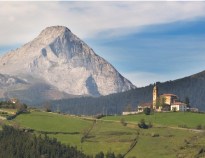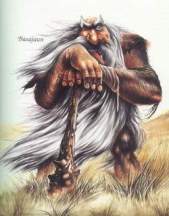Basque Mythology has survived in the Basque Country since prehistory. The basque people have always had a strong own culture and language, but later, their rites and beliefs were influenced by the Roman Empire and the Christianity.
The main deity in the Basque Mythology is Amalurra. The Earth is considered as the source that gives life to all beings and it is said that it holds many treasures inside.
Another imp ortant divinity in the Basque Mythology is the goddess Mari. She lives in all the basque mountaintops and her most important dwelling is the Anboto´s cave, therefore she is called The Lady of Anboto, too. Mari represents the nature and the supreme ethical power. She can appear as a beautiful woman, as an animal, as a tree or as a weather phenomenon. It is said that Mari crosses the sky as a bright light to go to the Txindoki mountain from the Anboto. Her movements have a great influence in the weather and when she is in the Anboto is the time of raining and when she is in another mountain the weather is sunny.
ortant divinity in the Basque Mythology is the goddess Mari. She lives in all the basque mountaintops and her most important dwelling is the Anboto´s cave, therefore she is called The Lady of Anboto, too. Mari represents the nature and the supreme ethical power. She can appear as a beautiful woman, as an animal, as a tree or as a weather phenomenon. It is said that Mari crosses the sky as a bright light to go to the Txindoki mountain from the Anboto. Her movements have a great influence in the weather and when she is in the Anboto is the time of raining and when she is in another mountain the weather is sunny.
The partner of Mari is Maju or Sugar. He is a darker god and he can appear as a man or as a snake or a dragon. He lives in other caves such as Amunda, Baltzola or Atarreta. He has two sons: Mikelatz (represents evil) and Atarabi (represents good). Maju was related with the Princess of Mundaka and it is said that Jaun Zuria, the first mythological Lord of Biscay, was the result of this relationship.
Another divinity with great relevance is Eguzki Amandre, the Sun. She gives us the light and the heat and has the power to eliminate all the bad geniuses and the darkness. In many legends the Sun is considered as the God´s eye and a very extended tradition is to put an Eguzkilore (flower of the sun) in the doors of the houses to keep away the bad spirits. More information about the Eguzkilore.
Ilargi Amandre is the divinity of the Moon. She is considered as the God´s face and the light of the dead people. The last important deity is Urtzi, the Sky. It is said that this divinity has been influenced by the Norse mythology because of his similarity with the God Thor.
Apart from the divinities there are a lot of geniuses and elves. Some of them are:
- Basajaun: He is the Lord of the Forests. He is represented as a big man covered of hair with a claw-shaped foot. He helps the shepherds with their flocks and is a master of many crafts.
- Lamia: She is similar to the sirens or the nymphs. She is represented as a beautiful woman waist up but with flippers, hooves or fishtail depending on the zone where the lamia lives. Her favourite activity is to comb her long hair with
 a golden comb. She helps the humans when they need help but she can also be very evil if she doesn´t get what she wants.
a golden comb. She helps the humans when they need help but she can also be very evil if she doesn´t get what she wants. - Jentilak: They were the first settlers of the Basque Country. They were very big and strong and could launch boulders great distances. With the arrival of Christianity they had to move to remote areas and they disappeared.
- Sorginak: They are female and evil geniuses sometimes. They could be priestesses of Mari. On Friday evening they celebrate the Akelarre, which was a meeting to worship the genius Akerbeltz.
- Tartalo: Is a terrifying cyclop who eats men and works as a pastor. It has a big influence from the greek mythology.
- Olentzero: He was a jentil but with the arrival of the Christianity it was adapted to the new religion. He was related with the time of the winter solstice and the burning of all the old things. Nowadays, he brings presents to the people announcing the birth of Christ and brings coal to those who have misbehaved.
- Iratxoak: They are elves that make mischiefs for the humans. The can appear in many different forms of animals or goblins. They are related to the ferns and they live in caverns and wells.
There are so much geniuses in the Basque Mythology and there are a lot of legends and stories about them such as the Galtxagorris, the legend of Martin Txiki or the Greedy Lamia. One of the most important writers and researchers was J.M Barandiaran, who wrote several books about the Basque Mythology. Nowadays, it is becoming more popular because of the foundation of some museums such as the JM Barandiaran of Ataun Museum and the Mythological Park of Mungia.
To sum up, I would say that the Basque Country has a rich mythology that has been influenced by many countries such as the nordic or the romans. One of the most remarkable characteristics of the Basque Mythology is that is matriarchal, and the female divinities are more than the male. It is very ancient and, like all mythology, contains a deep and complex meaning, therefore, I think that it is very interesting and it is a good idea to make it more known.
Bibliography:
- By Koldo Alijostes Bordagarai: https://sites.google.com/a/amaroa.com/mitologia-vasca/antiguas-divinidades
- By Koldo Alijostes Bordagarai: https://sites.google.com/a/amaroa.com/mitologia-vasca/personajes-mitologicos-de-vasconia
- http://www.portalvasco.com/historia/histo5.html
- http://www.ekiria.org (image)
- http://ruralconencanto.wordpress.com/2010/11/25/anboto-una-montana-magica/(image)
Filed under: Blogs and forums, History, Humanities, Uncategorized, Web Communication Tagged: Basque Country, history, Mythology
![]()